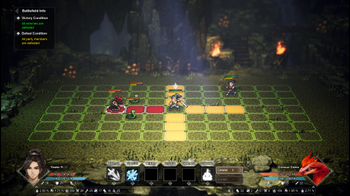
Wandering Sword sprinkles some Live A Live on top of its unique blend of wuxia and HD-2D pixel art
Take two seconds to glance at any screenshot or footage of Wandering Sword and you’ll know where it takes its visual inspiration from right away, if you’ve been keeping up with RPGs for the past few years. That’s not necessarily a bad thing either; the developers at The Swordsman Studio proudly present their own take on the HD-2D pixel art style that was first introduced in 2018’s Octopath Traveler. Both are powered by Unreal Engine 4 after all, so Wandering Sword most assuredly was built from learning how Octopath Traveler achieved it.
I got the chance to play the demo of Wandering Sword early. It is now available to download for a limited time from February 6 to February 28 as part of Steam Next Fest. The demo is a pretty sizable first slice of the game that took me about three and a half hours to finish. I came away intrigued with the potential that Wandering Sword offers with its gameplay systems, though its initial hour almost put me off entirely due to its slow pace admittedly.
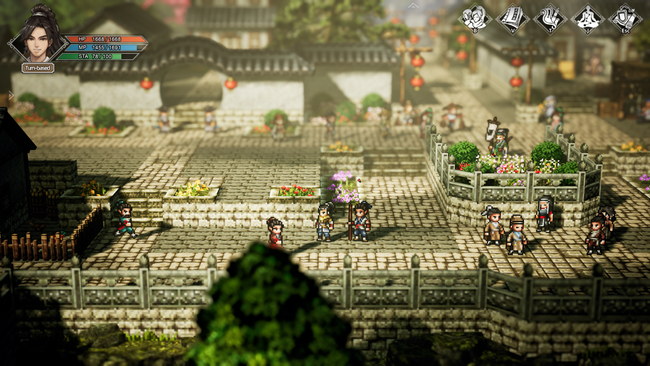
Wandering Sword presents a compelling pitch from the get-go; it is a HD-2D RPG that blends the combat of Live A Live within the framework of a wuxia. If you’re unfamiliar with wuxia, it refers to a specific genre in Chinese fiction that incorporates a hero’s journey through martial arts after suffering a tragedy. Wuxia has had a very rich history in media for many, many years; several popular wuxia films in the west that you may have seen are Hero, House of Flying Daggers, and Crouching Tiger, Hidden Dragon.
In Wandering Sword, players take control of a young man named Yuwen Yi after his caravan was inexplicably attacked. His life was spared thanks to Master Qingxu, the mysterious individual that the caravan was transporting. Unfortunately, they were the only survivors though Yuwen Yi is barely hanging onto life due to a powerful Frostvenom poison from the incident. Qingxu drops off Yi with Jiang Yinfeng to look after him and much of the opening hour is spent slowly going through tutorials finding a way to detoxify Yi.
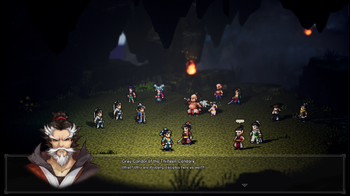
It initially gave me a bad first impression because this opening segment is your typical “first village” experience in a RPG. Not many interesting mechanics have opened up yet, the dialogue isn’t all that engaging because it’s so early, and even worse - the side quests you incidentally pick up from random town NPCs are all utterly boring fetch quests. Keep in mind, this is still an early demo for Wandering Sword, so this may not be reflective of the final game.
There is a significant turning point in the narrative, of course, that truly gets Yi on the path to becoming a classic wuxia protagonist - and this is where it started to get interesting to me. I don’t specifically want to elaborate on the specifics of what happens, but it did get me intrigued on what the overall scope of the game will be in its full release. Several factions with their own motivations begin to clash with one another that greatly expand the stakes of the story.
As I mentioned earlier, Wandering Sword is coming at an interesting time when Live A Live itself received a HD-2D remake last year that was officially released in the west for the first time. Wandering Sword’s battle system is heavily reminiscent of Live A Live even in its presentation. When players are thrust into a combat encounter, their party finds themself on a grid tile-based arena facing off against foes. Everyone’s life bar is displayed, along with an action bar that fills up underneath it; Wandering Sword refers to this action bar as qi gathering and when enough qi is gathered, an ally or enemy can take their turn.
Unlike Live A Live, the action bar only moves forward when a player and/or enemy ends their turn. It does not immediately go up per tile moved on the grid. Therefore, players can choose to undo an ally’s movement if they misclicked a tile or want to reevaluate their strategy before committing to an attack or passing their turn.
Several types of attacks are available to the player - Normal, Special, Mighty, and Unique. Every type of attack aside from Normal attacks have cooldowns. Wandering Sword does a decent job breaking down what skills do in their tooltips when hovering over them, though the information can seem overwhelming at first because it displays so much text at once - including their effects when reaching a certain level threshold. Perhaps the full breakdown should be on a toggleable hotkey to expand the text with all that additional info, so the wall of text can be trimmed a bit.
There are two other commands available in battle, Lightness and Cultivation. These are more utility focused with Lightness granting a temporary buff on movement and Cultivation restoring HP.
Although Wandering Sword’s battle system can be toggled between “turn-based” and “real-time”, they’re functionally identical. In real-time, the HUD and presentation remain the same, but everyone’s action bars are always going up. Only Yi is controlled by the player, while all allies automatically move and act on their own. Real-time seems useful to speed up encounters against weaker foes and seems dangerous to switch to for tougher encounters that require finer control.
The potential of the battle system is best showcased in the demo when a massive amount of enemies are on the field ready to strike down the player. There was a particular narrative sequence that even had a 3-way struggle with foes fighting amongst themselves, while players had to carefully navigate the battlefield to survive. Seasoned enemy combatants were constantly pulling off powerful attacks among each other, while the player’s current circumstances were considerably dire.
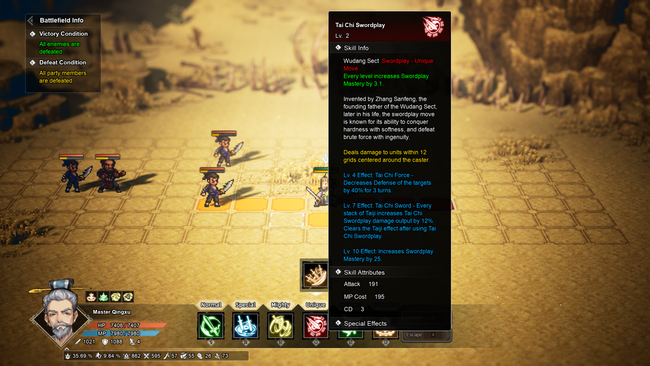
Additionally, Wandering Sword does not exhibit a traditional leveling system for its characters.
The skills available to characters are decided based on the type of weapon they wield; learning new skills come from upgrading the basic weapon mastery skill and through finding manuals that teach new skills for specific weapons types.
In order to upgrade Yi’s stats, players must upgrade his Cultivation Method skills. These grant Meridian Points that can be spent on six different Vessels that specialize in certain stats. The terminology might be confusing, but it’s essentially upgrading a certain type of skill (Cultivation Method) to gain skill points. These skill points can then be spent on six different linear trees that all focus on different stats. For instance, the Yang Vessel focuses on offense since it upgrades ATK and CRIT only, while the Governing Vessel raises HP and DEF.
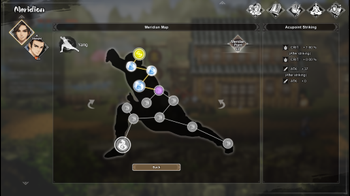
One of the things that excites me about Wandering Sword is how players obtain party members. When speaking with a NPC, there is sometimes an option to Observe them. When observing a NPC, players can view that NPC’s item inventory, their Affection level underneath their name, and several different options to interact with them. Usually, the Spar and Gift options are available for most NPCs. After raising their Affection level to 20 through gifts they like, Yi can spar against them. If he’s victorious, they’ll give him one of their items.
Some specific NPCs have an Invite option which can potentially make them a party member if a player manages to get their affection level to 60. It makes me wonder how many optional party members there will be and if the main story will introduce any permanent party members throughout Yi’s wuxia adventure. There are a few temporary party members that I wish were permanent already. I’m so curious on what the final playable roster’s total will be when all the optional party members are recruited and if there will be missable ones, or if there are ones that players will have to miss if they recruited another specific character instead that locks them out of one.
There are also small touches to Wandering Sword that help immerse players into its world. NPCs randomly roam around on the world map as players go from one locale to another. One of the bigger cities players come across in the demo has a considerable amount of background NPCs running around to maintain a bustling atmosphere.

My favorite moment in the Wandering Sword demo is seeing the progression of Yi’s power level. Later in the demo, Yi meets a temporary party member after breaking out of prison. He still has very few skills and combat options to work with at that time, but he just recently learned an (incomplete) martial art skill that allows him to somewhat fight back competently - a classic wuxia trope.
The new party member and Yi decide to temporarily work together to clear out a thieves' den to rescue kidnapped children. Although the enigmatic party member is considerably more powerful and capable than Yi, he is able to barely stand his own ground through gameplay. Thanks to the bountiful amount of experience points the thieves are giving, Yi is able to level his skills and stats more than ever before, along with new powerful equipment either dropped from enemies or found in chests.
By the time this moment in the story is over and the temporary party member leaves, Yi felt like a character coming into his own and it was all presented through gameplay alone. It provided one of the most iconic traits from wuxia tales through a gameplay framework and it was done effectively. This is probably my biggest hope for Wandering Sword; I hope the game is able to provide this type of feeling consistently in its final release.
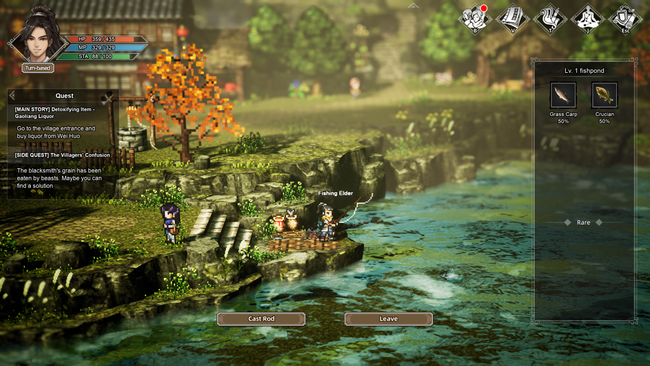
Wandering Sword seems promising, though I wonder how far off its full release is. Its UI and menu designs feel incomplete, the depth-of-field effect feels too intense, and the English script is stiff in several interactions. Despite my early grievances, I remain overall optimistic about Wandering Sword. The scope of the story seems larger than I initially expected and I’m enthusiastic to see what kinds of people Yi will encounter on his wuxia journey.
